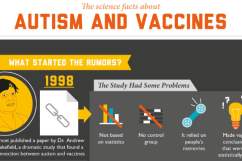
(YouTube)
Sesame Street has always taken steps to ensure everyone is represented on the show. It’s just one of the many reasons that it is two years away from celebrating its 50th anniversary. Sesame Workshop has taken another big step by adding the first Muppet character with autism, Julia.
By introducing Julia on Sesame Street, the Sesame Workshop team hopes to introduce other children to autistic behavior at a young age so they know that other children just happen to be different and that’s not a bad thing.
Here’s a look at Julia and the puppeteer behind her, Stacey Gordon.
1. Julia Was Introduced in a 2015 Animated Video About Autism
Julia has actually been a member of the Sesame Street family for two years now. In 2015, she appeared in an animated storybook as part of the Sesame Street and Autism: See the Amazing in All Children nationwide outreach initiative.
In the videos and in Julia’s subsequent appearances on the TV show, it’s established that Elmo is Julia’s closest friend. In the cartoon seen above, Abby thinks Julia doesn’t like her because it looks like Julia is ignoring her.
“No, Abby. Elmo doesn’t think that’s true. Julia sometimes does things differently because Julia has autism,” Elmo explains. He later tells Abby, “Abby could use fewer words, and wait a little bit. That usually works for Elmo.”
This sequence was similar to one seen in the March 19 60 Minutes episode, in which Lesley Stahl visited the set when Julia was introduced to Big Bird.
“We had to explain to Big Bird that Julia likes Big Bird. It’s just that Julia has autism. So sometimes it takes her a little longer to do things,” Elmo told Stahl.
2. Puppeteer Stacey Gordon’s Son Also Has Autism
Veteran puppeteer Stacey Gordon was chosen to play Julia. She’s the founder of Puppet Pie and the member of an improv puppet group Die Puppet Die.
Playing Julia is very personal for the 37-year-old Phoenix resident, as her son also has autism. In an interview with 60 Minutes, Gordon said that having an autistic character on Sesame Street means “that our kids are important enough to be seen in society.”
“Had my son’s friends been exposed to his behaviors through something that they had seen on TV before they experienced them in the classroom, they might not have been frightened. They might not have been worried when he cried,” Gordon explained to Lesley Stahl. “They would have known that he plays in a different way and that that’s OK.”
In an interview with Phoenix People, Gordon said she was also a nanny for an autistic child. She explained:
When I was in college, I was a nanny, and when we moved to Phoenix, I went through a local nanny agency and found a family that needed a habilitation therapist for their child with autism. I got trained in that and was a therapist for kids with autism until I got pregnant with my own child who, as it turns out, has autism. Being a stay-at-home mom allowed me to pursue puppetry full-time.
3. 1 in 68 American Children Have Been Diagnosed with Autism Spectrum Disorder
A Muppet on Sesame Street with Autism is another sign of how common it is for children to meet another child with autism. According to the Centers for Disease Control and Prevention, about one in 68 children in America have been diagnosed with autism spectrum disorder (ASD), as of 2012. That’s 1.5 percent of children in the U.S. The CDC notes that ASD knows no boundaries, occurring in all races, ethnicities and socioeconomic groups.
As Autism Speaks noted in November 2015, there was another government survey of parents that suggested one in 45 children between the ages of 3 and 17 have ASD. The difference is due to this one being a survey of parents, not a number of those being diagnosed. Therefore, it shows that some children who have autism might not be diagnosed.
Autism Speaks explained that it will stick with the 1-in-65 statistic, but they didn’t completely dismiss the 2015 survey.
“The 1 in 45 estimate is not surprising and is likely a more accurate representation of autism prevalence in the United States,” epidemiologist Michael Rosanoff, Autism Speaks director for public health research, said in a statement. “This means that 2 percent of children in the U.S. are living with autism. The earlier they have access to care, services and treatment, the more likely they are to progress.”
Julia isn’t representative of most children with autism, as the majority of children diagnosed with autism are boys. One in 189 girls have autism, compared to one in 42 boys. In a 2015 interview with the Los Angeles Times, Sherrie Westin, Sesame’s executive vice president, global impact and philanthropy, explained that they purposefully chose to make Sesame‘s first Muppet with autism a girl.
“We made sure she was a girl namely because autism is seen so much more often in boys,” she told the LA Times. “We wanted to make it clear that girls can be on the spectrum, too. .. We’re trying to eliminate misconceptions, and a lot of people think that only boys have autism.”
4. Julia’s First Appearance on ‘Sesame Street’ Will Air on April 10
Sesame Workshop announced that the special Sesame Street episode titled “Meet Julia” will air on April 10, simultaneously on HBO and PBS Kids in the U.S. It will also debut on the same day on Cartoonito UK in the U.K., ABC Network in Australia and Televisa in Mexico.
“Bringing Julia to life as a Sesame Street Muppet is the centerpiece of all of our new materials to support families of children with autism,” Sherrie Westin, EVP of Global Impact and Philanthropy, Sesame Workshop, said in a statement. “The response from the autism community to See Amazing in all Children has been extraordinary, and we are committed to continuing our efforts to promote understanding and acceptance of autism, as part of our mission of helping all children grow smarter, stronger, and kinder.”
Sesame Workshop said that “Meet Julia” was made after consulting with over 250 organizations and experts about autism. Writer Christine Ferraro, who penned “Meet Julia,” also has a personal relationship with autism.
“For years, families of children with autism have asked us to address the issue. We heard a call to use our expertise and characters to build a bridge between the autism and neurotypical communities,” Dr. Jeanette Betancourt, SVP of U.S. Social Impact, Sesame Workshop, said in a statement. “So many partners, advisors, and organizations have contributed to the success of this initiative, and we are thrilled to have the benefit of this collaboration as we launch this latest chapter.”
5. Julia Is the First New Muppet on Sesame Street Since Abby Cadabby
As NPR notes, Julia is the first new Muppet character on Sesame Street in a decade. The previous new character was Abby Cadabby, a three-year-old fairy who first appeared in 2006. She has become so popular that she has her own CGI segment called Abby’s Flying Fairy School.
“I would love her to be not Julia, the kid on Sesame Street who has autism. I would like her to be just Julia,” Ferraro told 60 Minutes.
“She’s one of the kids, she’s one of the gang,” Rose Jochum, director of internal initiatives at the Autism Society of America, told NPR. “It’s really meaningful to see her there, singing with Elmo, Big Bird and all the other characters. It’s great.”




Comments
Julia on ‘Sesame Street’: 5 Fast Facts You Need to Know